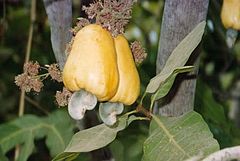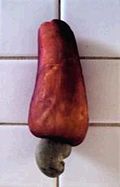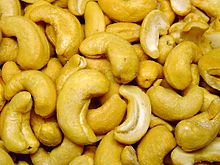Cashew: Difference between revisions
No edit summary |
m Added photo of unsalted cashews |
||
| Line 32: | Line 32: | ||
Originally spread from Brazil by the Portuguese, the cashew tree is now cultivated in all regions with a sufficiently warm and [[humidity|humid]] climate. India, Vietnam, and Brazil, in that order, are the largest producers of cashew kernels; collectively they account for more than 90% of all cashew kernel exports. One of the finest varieties of cashews come from [[Kollam]] or [[Quilon]] in [[Kerala]], South India which alone produces 4000 tons of cashews per annum. |
Originally spread from Brazil by the Portuguese, the cashew tree is now cultivated in all regions with a sufficiently warm and [[humidity|humid]] climate. India, Vietnam, and Brazil, in that order, are the largest producers of cashew kernels; collectively they account for more than 90% of all cashew kernel exports. One of the finest varieties of cashews come from [[Kollam]] or [[Quilon]] in [[Kerala]], South India which alone produces 4000 tons of cashews per annum. |
||
| ⚫ | |||
The cashew apple is used for its juicy but acidic pulp, which can be eaten raw or used in the production of [[jam]], [[chutney]], or various beverages. Depending on local customs, its juice is also processed and distilled into [[liquor]] or consumed diluted and sugared as a refreshing drink, [[Cajuína]]. Ripe cashew apples also make good [[caipirinha]]. In [[Goa]], India, the cashew apple is the source of juicy pulp used to prepare ''[[fenny]]'', a locally popular distilled liquor. The cashew apple contains much [[tannin]] and is very perishable. For this reason, in many parts of the world, the false fruit is simply discarded after removal of the cashew nut. |
The cashew apple is used for its juicy but acidic pulp, which can be eaten raw or used in the production of [[jam]], [[chutney]], or various beverages. Depending on local customs, its juice is also processed and distilled into [[liquor]] or consumed diluted and sugared as a refreshing drink, [[Cajuína]]. Ripe cashew apples also make good [[caipirinha]]. In [[Goa]], India, the cashew apple is the source of juicy pulp used to prepare ''[[fenny]]'', a locally popular distilled liquor. The cashew apple contains much [[tannin]] and is very perishable. For this reason, in many parts of the world, the false fruit is simply discarded after removal of the cashew nut. |
||
The urushiol must be removed from the dark green nut shells before the seed inside is processed for consumption; this is done by shelling the nuts, a somewhat hazardous process, and exceedingly painful skin rashes (similar to poison-ivy rashes) among processing workers are common. In India urushiol is traditionally used to control tamed elephants by its [[mahout]] (rider or keeper). The so-called "raw cashews" available in health food shops have been cooked but not roasted or browned. |
The urushiol must be removed from the dark green nut shells before the seed inside is processed for consumption; this is done by shelling the nuts, a somewhat hazardous process, and exceedingly painful skin rashes (similar to poison-ivy rashes) among processing workers are common. In India urushiol is traditionally used to control tamed elephants by its [[mahout]] (rider or keeper). The so-called "raw cashews" available in health food shops have been cooked but not roasted or browned. |
||
| ⚫ | |||
Cashew nuts are a common ingredient in [[Asian_cuisine|Asian cooking]]. They can also be ground into a spread called cashew butter similar to [[peanut butter]]. Cashews have a very high [[Vegetable oil|oil]] content, and they are used in some other nut butters to add extra oil. In an off-the-shelf package of cashews found in the [[United States]], a 30-gram serving contained 180 calories (750 kilojoules), 70% of which was fat. |
Cashew nuts are a common ingredient in [[Asian_cuisine|Asian cooking]]. They can also be ground into a spread called cashew butter similar to [[peanut butter]]. Cashews have a very high [[Vegetable oil|oil]] content, and they are used in some other nut butters to add extra oil. In an off-the-shelf package of cashews found in the [[United States]], a 30-gram serving contained 180 calories (750 kilojoules), 70% of which was fat. |
||
Revision as of 16:19, 7 January 2007
| Cashew | |
|---|---|

| |
| Cashews ready for harvest in Guinea-Bissau | |
| Scientific classification | |
| Kingdom: | |
| Division: | |
| Class: | |
| Order: | |
| Family: | |
| Genus: | |
| Species: | A. occidentale
|
| Binomial name | |
| Anacardium occidentale | |

The Cashew (Anacardium occidentale) is a tree in the flowering plant family Anacardiaceae. The plant is native to northeastern Brazil, where it is called by its Portuguese name Caju (the fruit) or Cajueiro (the tree). It is now widely grown in tropical climates for its cashew "nuts" (see below) and cashew apples.

It is a small evergreen tree growing to 10-12 m tall, with a short, often irregularly-shaped trunk. The leaves are spirally arranged, leathery textured, elliptic to obovate, 4-22 cm long and 2-15 cm broad, with a smooth margin. The flowers are produced in a panicle or corymb up to 26 cm long, each flower small, pale green at first then turning reddish, with five slender, acute petals 7-15 mm long.
What appears on the tree to be the fruit of the cashew tree is an oval to pear-shaped accessory fruit or false fruit that develops from the receptacle of the cashew flower. Called the cashew apple, better known in Central America as "marañón", it ripens into a yellow and/or red structure about 5–11 cm long.
The true fruit of the cashew tree is a kidney or boxing-glove shaped drupe that grows at the end of the pseudofruit. Actually, the drupe develops first on the tree, and then the peduncle expands into the pseudofruit. Within the true fruit is a single seed, the cashew nut. Although a nut in the culinary sense, in the botanical sense the fruit of the cashew is a seed. However, the true fruit is classified as a nut by some botanists. The seed is surrounded by a double shell containing a caustic phenolic resin, urushiol, a potent skin irritant toxin (also found in the related poison-ivy). Some people are allergic to cashews, but cashews are a less frequent allergen than some other nuts.
Other vernacular names include cajueiro, cashu, casho, acajuiba, caju, acajou, acaju, acajaiba, alcayoiba, anacarde, anacardier, anacardo, cacajuil, cajou, gajus, jocote maranon, maranon, merey, noix d’acajou, pomme cajou, pomme, jambu, jambu golok, jambu mete, jambu monyet, jambu terong, kasoy.
Uses

Originally spread from Brazil by the Portuguese, the cashew tree is now cultivated in all regions with a sufficiently warm and humid climate. India, Vietnam, and Brazil, in that order, are the largest producers of cashew kernels; collectively they account for more than 90% of all cashew kernel exports. One of the finest varieties of cashews come from Kollam or Quilon in Kerala, South India which alone produces 4000 tons of cashews per annum.


The cashew apple is used for its juicy but acidic pulp, which can be eaten raw or used in the production of jam, chutney, or various beverages. Depending on local customs, its juice is also processed and distilled into liquor or consumed diluted and sugared as a refreshing drink, Cajuína. Ripe cashew apples also make good caipirinha. In Goa, India, the cashew apple is the source of juicy pulp used to prepare fenny, a locally popular distilled liquor. The cashew apple contains much tannin and is very perishable. For this reason, in many parts of the world, the false fruit is simply discarded after removal of the cashew nut.
The urushiol must be removed from the dark green nut shells before the seed inside is processed for consumption; this is done by shelling the nuts, a somewhat hazardous process, and exceedingly painful skin rashes (similar to poison-ivy rashes) among processing workers are common. In India urushiol is traditionally used to control tamed elephants by its mahout (rider or keeper). The so-called "raw cashews" available in health food shops have been cooked but not roasted or browned.
Cashew nuts are a common ingredient in Asian cooking. They can also be ground into a spread called cashew butter similar to peanut butter. Cashews have a very high oil content, and they are used in some other nut butters to add extra oil. In an off-the-shelf package of cashews found in the United States, a 30-gram serving contained 180 calories (750 kilojoules), 70% of which was fat.
The liquid contained within the shell casing of the cashew, known as Cashew Nut Shell Liquid (CNSL), has a variety of industrial uses which were first developed in the 1930s. CNSL is fractionated in a process similar to the distillation of petroleum, and has two primary end products: solids that are pulverized and used as friction particle for brake linings, and an amber-colored liquid that is aminated to create phenalkamine curing agents and resin modifiers. Phenalkamines are primarily used in epoxy coatings for the marine and flooring markets, as they have intense hydrophobic properties and are capable of remaining chemically active at low temperatures.
References and external links
- Morton, J. F. Fruits of Warm Climates. ISBN 0-9610184-1-0
- Fruits of Warm Climates online
- Handbook of Energy Crops - Anacardium occidentale L.
- Cajueiro - Tropical plant database by Raintree Nutrition
- History of the industrial use of Cashew Nutshell Liquid
- King's American Dispensatory: Anacardium occidentale (Cashew-Nut)
- Research Paper on the Cashew Processing Industry in West Africa
